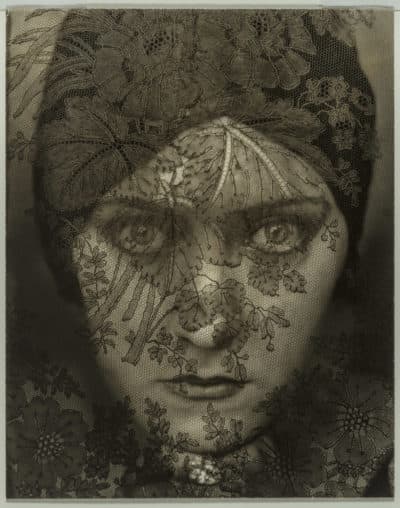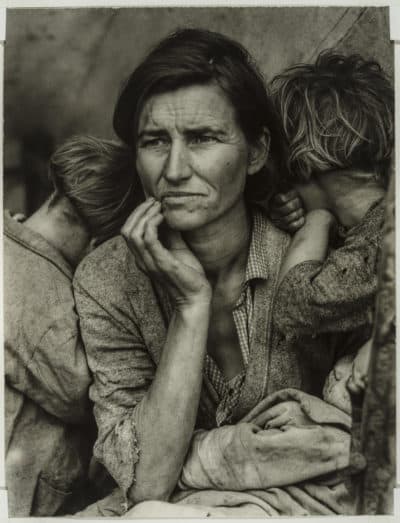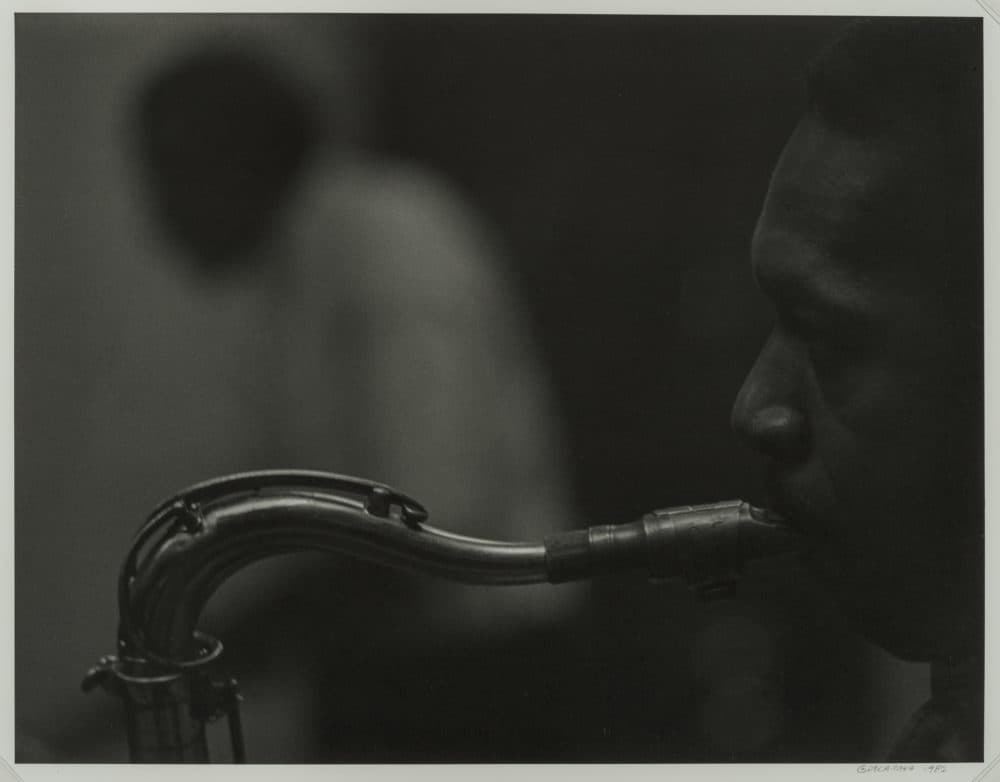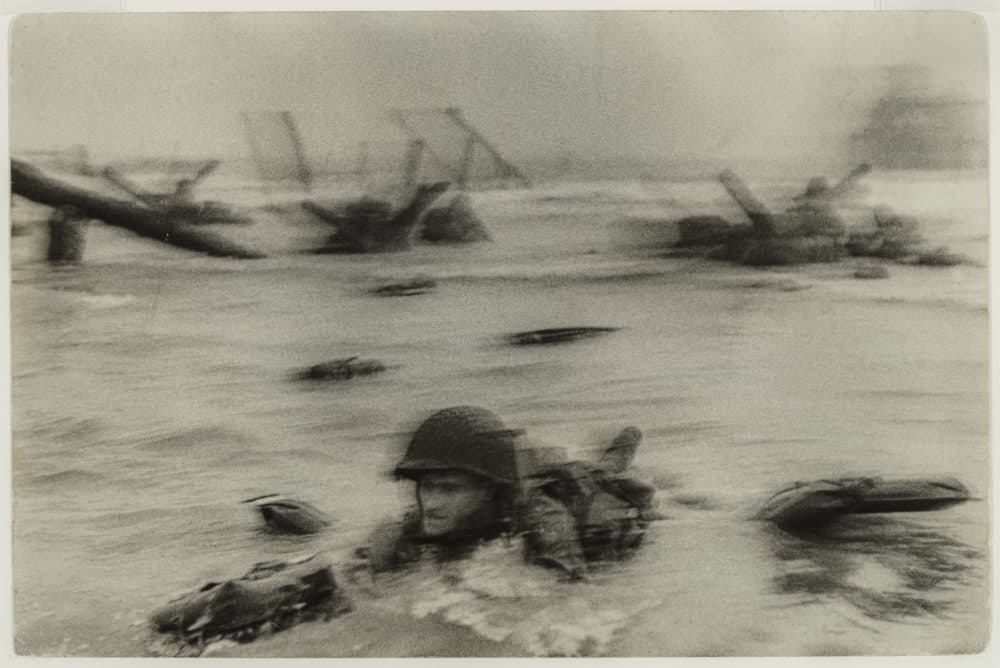Advertisement
From Dorothea Lange To Robert Capa: MFA Acquires Collection Of Iconic 20th Century Photographs
The worried, sun-worn face of a migrant pea farm worker struggling to feed her seven children during the Great Depression. A gear-laden soldier swimming for his life in Normandy on D-Day. Silent actress Gloria Swanson’s veiled, wide, piercing eyes circa 1924.
These are just three of the 447 indelible and rare images in the stellar photography collection recently acquired by Boston's Museum of Fine Arts.
The trove was amassed by Howard Greenberg, an influential New York City art dealer, over 35 years. It features works by 191 artists including Robert Capa, Edward Steichen, Roy DeCarava, Dorothea Lange, Henri Cartier-Bresson, Walker Evans and Consuelo Kanaga.
The acquisition is "transformational" for the MFA's photography collection and "make [the museum] a vital place for the story of 20th century photography," says the institution's chair of photography Anne Havinga. It builds on existing holdings, including prints donated to the museum by American photographer Alfred Stieglitz in 1924 and the Lane Collection of more than 6,000 pictures — including 500 by Ansel Adams – given to the MFA in 2012.
Greenberg's collection covers two major areas of work: fine, iconic classics (especially from the wars in Europe) and pictures that document social history and the breadth of human experience.

When asked to choose a few photographs that show the collection's range, curator Anne Havinga started with a portrait of silent movie actress Gloria Swanson, taken by Edward Steichen.
“It's one of the most celebrated portraits of the 20th century, and the definitive image of the star. It was made by Steichen when he was relatively newly-appointed as the photographer at Condé Nast," Havinga says. "She has an incredible direct look that is also alluring. She looks like a modern independent woman, and yet it has overtones of the softness of his earlier work.”
“It's a fabulous image,” the curator went on. One of the unique things about Greenberg's collection is the first-rate prints, she says. "The specific prints that we're acquiring are rare and extraordinary and sometimes the most special print that exists of that work.”
As a pillar in New York’s photographic scene, Greenberg had access to photographers with a broad range of approaches and sensibilities, Havinga said.
To contrast Steichen, the curator turned to photojournalist and documentarian Dorothea Lange’s “Migrant Mother, Nipomo, California,” which was taken a decade later in 1936.
“It is an icon of the Great Depression,” Havinga says.

Lange took this photograph when she was hired to capture the plight of sharecroppers and farm families for the Resettlement Administration, an agency created as part of the New Deal. As she traveled through California, Lange passed a camp of unemployed migrant workers where she found a mother with her seven children. Her name was Florence Owens Thompson.
“The mother has her chin in her hand propped up by her elbow in her lap. The face of the mother is one of worry and resignation and hardship,” the curator describes. “They had been eating only frozen vegetables, and the mother had actually just sold the tires from her car in order to buy food.”
The photograph was made with a large format camera and it's tightly cropped.
Then there’s another image from the 1930s by Henri Cartier-Bresson. He took it in Madrid early in his career. “He had just acquired his hand-held Leica — a 35 mm camera — and he was spending the these years traveling in Europe and photographing urban street scenes,” Havinga says.
It has a group of kids in the foreground. A white wall fills in the background. There are small square windows of varying sizes polka-dotting the wall. A grown man saunters through the center of the frame.
“It's a picture that shows the intricate geometry of space in a photograph,” the curator says. “Cartier-Bresson later on became well known for the term 'decisive moment,' which is about capturing the precise moment of an event in which the organization of the forms in the space also lend meaning to the subject.”

The new collection also captures the African-American experience spanning the 1930s through the civil rights era. Another photo Havinga was eager to talk about is “Young Girl in Profile,” taken in 1948 by Consuelo Kanaga.
“One of the extraordinary special things about this is the really beautiful tones in the print, the tone of her skin, the tone of her white blouse — the whites are almost creamy, the dark tones are warm," Havinga says. "It's just a very moving picture.”

The curator points out Roy DeCarava’s “Coltrane and Elvin,” which was taken in 1960.
“He's one of the great American photographers from the mid-late 20th century,” she says. “One of the themes in his work was the jazz scene in New York, and he made pictures that are poetically beautiful, that just have a great sense of form and meaning and resonance and poignancy.”

Finally, Havinga highlights an important piece from Greenberg’s war photos. Robert Capa was among the first wave of soldiers on Omaha Beach during the Normandy invasion in 1944. “He snapped a lot of pictures,” the curator explains, “including this one of a soldier swimming to the shore. There's an expression of sort of stoic defiance as he's trying to make it to the shore with the gunfire all around him.”
Only a small number of Capa’s film rolls made it to Life Magazine’s London office, and Havinga says this is the best existing original print of this documentary image.

Eighty of the 191 photographers in Greenberg’s collection haven’t been represented at the MFA — until now.
“This has a long lasting impact for the museum, and I think for Boston,” Havinga says. “It will allow us to show in much greater depth the story of the human experience in the 20th century. It will allow the museum to present exhibitions that will be about new kinds of stories, new kinds of narratives.”
This acquisition was funded through a major gift from the Phillip Leonian and Edith Rosenbaum Leonian charitable trust. The husband and wife were photography innovators in New York and ran a foundation to support the genre.
Greenberg is a "visionary collector," says museum director Matthew Teitelbaum in a statement. "The acquisition of these extraordinary works enriches a collection of art across time and cultures, at the highest level."
The collector himself says the MFA will be "a perfect resting place" for the photographs. “Especially gratifying are the MFA’s plans for exhibition, publication and programming around the collection. This will enable me to continue a lifelong mission of education and a deeper comprehension of photography as art and social medium.”
An exhibition of works from this collection will open next August at the MFA.
